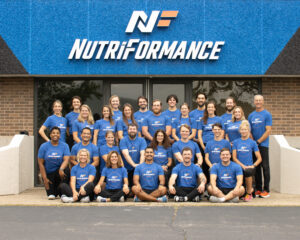The Functional Movement Screen
By Randy Leopando, BS, CSCS, FMS
Director of Personal Training and Performance Enhancement
In October of this year (2015), I will be spending my 18th year at NutriFormance. From a fitness industry perspective, a lot has changed and/or evolved over the years as a trainer. One thing continues to remain important at NutriFormance – functional training and the importance of proper movement patterns. Functional training involves a lot of movement-based strength exercises and core engagement. Proper movement patterns involve a good balance of core stability and joint mobility. One way we look at one’s movement quality is through the Functional Movement Screen (FMS).
The FMS looks at fundamental movements, motor control within movements, and a competence of basic movement patterns. Its job is to determine movement deficiency and uncover asymmetry. The evaluation is done by a simple grading system, and should be conducted by a certified professional.
The system was developed by Physical Therapist Gray Cook in 1998. The goal was to use the screen to add insight to movement problems that would ultimately lead to the best exercise choices and program design for individuals that would minimize risk of injury. The FMS is designed for all healthy, active people, and for healthy, inactive people who want to increase physical activity. It is designed for those that do not have pain or injury.
The FMS itself is a series of seven different movements. By screen, this does not mean it’s a diagnostic tool. The FMS is not diagnostic at all. It is a proven tool that looks objectively at quality of movement. It is extremely objective, reliable, and reproducible. It used by a wide range of health care professionals.
The seven tests require a balance of mobility and stability. Mobility and stability are the essential elements of the movement patterns in the FMS. If there are limitations in either, the FMS will reveal them. What often happens is people are putting exercise and performance on top of dysfunctional movement, which can impair performance and cause injuries.
Once the FMS has revealed a dysfunction, an appropriate exercise strategy can be implemented to correct the problem. This is part of the magic of the FMS and corrective exercise system.
If you have questions about the FMS, or would like to have the FMS screen conducted on yourself, contact me randyl@NutriFormance.com.
[fusion_builder_container hundred_percent=”yes” overflow=”visible”][fusion_builder_row][fusion_builder_column type=”1_1″ background_position=”left top” background_color=”” border_size=”” border_color=”” border_style=”solid” spacing=”yes” background_image=”” background_repeat=”no-repeat” padding=”” margin_top=”0px” margin_bottom=”0px” class=”” id=”” animation_type=”” animation_speed=”0.3″ animation_direction=”left” hide_on_mobile=”no” center_content=”no” min_height=”none”][/fusion_builder_column][/fusion_builder_row][/fusion_builder_container]

How to Choose a Personal Trainer
Thanks to the internet and social media, I’ve come across



